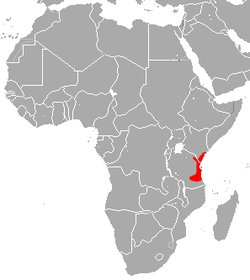| Decken's horseshoe bat | |
|---|---|
 | |
| Scientific classification | |
| Kingdom: | Animalia |
| Phylum: | Chordata |
| Class: | Mammalia |
| Order: | Chiroptera |
| Family: | Rhinolophidae |
| Genus: | Rhinolophus |
| Species: | R. deckenii |
| Binomial name | |
| Rhinolophus deckenii Peters, 1867 | |
 | |
| Decken's horseshoe bat range | |
Decken's horseshoe bat (Rhinolophus deckenii) is a species of horseshoe bat. It is found in Kenya and Tanzania. Its natural habitats are tropica and subtropical moist lowland and montane forest, moist savanna, caves and other subterranean habitats.
